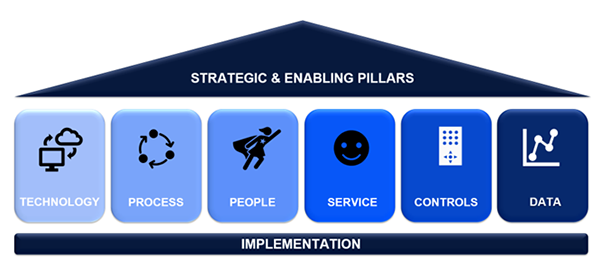 Against the backdrop of a changing world, with flexible work driving opportunities to work anywhere, emerging markets, and business growth, global payroll is increasingly a focal discussion at the board level with a drive to ensure compliance to keep risk profile low.
Against the backdrop of a changing world, with flexible work driving opportunities to work anywhere, emerging markets, and business growth, global payroll is increasingly a focal discussion at the board level with a drive to ensure compliance to keep risk profile low.
So where do you start with global payroll assessment and transformation? Here, we will share several critical aspects to help ensure your process is successful.
Discovery
The first step in this process is discovery, which begins when you have received approval to proceed. Thus, you have already formulated and presented your plan ahead of discovery, and you are prepared to mobilize.
Starting up your transformation programme is a five step approach. Seek to understand your as-is landscape by performing due diligence on your key strategic pillars (see Figure 1) and build your situational analysis to present to your key stakeholders for buy in.

Understand Your Markets
Global payroll is a standard framework in all countries but will have different local rules. Seek to understand these first, as it may shape your vision and direction around global standards. For example, money movement can’t be automated in all countries; you may need a local company bank account to make certain payments from. Determine whether you need a global vendor or if regional or aggregator models are options.
Meet, collaborate, and build relationships with key stakeholders who will support you on your journey and provide the right input because you will need their buy in and support.
Strategy is about achieving goals and objectives. Your goals and objectives are informed by your vision and mission, so your strategy creates your to-be and design phase. This is how you will take people on your transformation journey.
Transformations don’t just offer great business benefits, they offer people the opportunity to enhance their skillset, contribute to a project, grow, learn, and develop. Payroll is a transferable skill that can be used globally, but there is a difference in skillset between operationally running a payroll and implementing one, which is where the opportunity for skill enhancement lies.
Take the time to understand business strategy and how payroll’s objectives align. Consider the future of service offering to employees around payments. This could be a strategy looking at on-demand pay and cryptocurrency and funding models.
Gap Analysis
Begin to develop your key insights, address challenges, questions, and a strategic approach to your gaps. Prioritize gaps based on risk profile for business benefits.
Financial benefits through cost savings will always gain buy in from a cost-conscious business, but payroll cost saving is usually intangible. A global payroll transformation is not usually driven for cost saving; its value is found in regulatory compliance, visibility, reporting, and risk. Highlight areas with facts, opportunities, and risks.
This could involve reviewing areas such as your target operating model, re-engineering business processes, clearly identifying control points, reviewing key performance indicators (KPIs)/service level agreements (SLAs), case management, analysing data quality, and most importantly, being aware of what your technology and/or service provider is doing for you.
Technology is an enabler, not a magic trick. You want to have the right people around the table when decisions are being made. Even a small tweak to tech can create a change in a business process and require training for people to ensure compliance and service.
It is straightforward to implement a technological solution; it is not so straightforward to fix it when it’s live and rectify an implementation that was rushed and had the wrong decision makers around the table who don’t understand operational process. This can increase cost though remediation and generates frustration.
Perform solid due diligence on vendors. Their sales teams will sell you the world and tell you their technology can sing, dance, juggle, and automate everything. The reality is that it can’t, unless huge sums of money are invested.
Technology must work with business processes, people, service, controls, and data. Technology is a true partnership of evolution. Start with reviewing any contract of service, specifically ensure you are clear on termination rights, SLAs, KPIs, milestone payments during implementation, annual costs, and increases. Don’t be afraid to ask for service credits to aid performance management and your data to be provided in a specific format on termination.
Check supply chain management on local in-country providers (ICPs)—how are they managed and how does their technology fit with a global vendor’s middleware for aggregation?
RFx—A ‘Catch All’ Request
As you enter the phase of procuring resources of any kind for your project needs, you must be prepared to utilize this flexibility and use it strategically to ensure successful completion.
In this case, the RFx (a catch-all term used to describe any type of “Request for…”) can be used for the following:
1. Feel out the market and go with an RFI (request for information) to understand what vendors can offer you at a high level.
2. When you’ve shortlisted your vendors, move to RFP (request for proposal). Consider the following categories and ensure your key stakeholders have represented their areas:
- Service and support
- Governance
- Data and security (infosec)
- Processing
- Absence management, including time and attendance (T&A)
- Self-service
- Global mobility
- Implementation
- Training
- Commercials
- ICPs and offshoring
- Country-specific requirements
Make Your Business Case
You’ve put your heart and soul into this and you’re asking the business to sign off on CapEx (capital expenditure) investment for a transformation. What are the benefits?Offer decision makers options, recommendations, and outline risks for all. Know your stakeholders and what resource you need.
Consider the following:
- Project definition and background—What are you trying to achieve and why?
- Objectives
- Scope (what’s in and what’s out)
- Expected outcome–business benefits
- Dependencies and assumptions
- Approach and timescale (include a high-level plan)
- Risks and issues
- Options and recommendations
- Costs and ROI—you can include resource allocation here
- Governance
- Add any supporting documents to an appendix
Implementation
Develop a delivery structure and approach, design principles, set up a steering committee, and design authority. Ensure you have sufficient governance in place to manage your project/program and provide the business with regular status updates against milestones (see Figure 2).

A transformation is not a straight line of A-to-B. It is likely you will have hurdles to overcome that can be stressful. Create a team than works well behaviorally and technically together and ensure there is strong and supportive leadership in place. Back fill BAU (business as usual) roles for business insight, include people from multiple countries, and bring in external resources. A blended team of skillsets will add significant insight and value.
Create a partnership with your vendor!
Be aware of any other projects that have an impact of dependency against yours.
Consider the following roles:
- Change Management
- Solution Architecture
- Data Migration
Enjoy the journey, have fun, learn, and utilise strong skillsets around you to deliver a quality solution on time and within budget.
Find out more about the author in this issue’s Professional Spotlight.